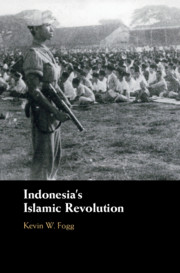Book contents
- Indonesia’s Islamic Revolution
- Indonesia’s Islamic Revolution
- Copyright page
- Contents
- Acknowledgments
- A Note on Indonesian Names
- Map
- Introduction
- 1 Islam in Indonesia before the Revolution
- Part I Islam in Indonesia’s War of Independence
- 2 Islamic Calls to Action
- 3 Ulama, Islamic Organizations, and Islamic Militias
- 4 Magic, Amulets, and Trances
- 5 Social Revolution
- 6 Darul Islam
- Part II Islam in Indonesia’s Political Revolution
- Conclusion
- Appendix: Oral History Sources
- Glossary
- Bibliography
- Index
2 - Islamic Calls to Action
from Part I - Islam in Indonesia’s War of Independence
Published online by Cambridge University Press: 18 November 2019
- Indonesia’s Islamic Revolution
- Indonesia’s Islamic Revolution
- Copyright page
- Contents
- Acknowledgments
- A Note on Indonesian Names
- Map
- Introduction
- 1 Islam in Indonesia before the Revolution
- Part I Islam in Indonesia’s War of Independence
- 2 Islamic Calls to Action
- 3 Ulama, Islamic Organizations, and Islamic Militias
- 4 Magic, Amulets, and Trances
- 5 Social Revolution
- 6 Darul Islam
- Part II Islam in Indonesia’s Political Revolution
- Conclusion
- Appendix: Oral History Sources
- Glossary
- Bibliography
- Index
Summary
Saifulkan Angai was sixteen years old when the Dutch came back to South Kalimantan in 1946 as part of their efforts to reclaim their colony. Faced with revolution, he joined the Muhammadiyah Islamic organization and enlisted in the organization’s local militia for the struggle against the colonizers and their troops. Crucial to his involvement in the militia were the exhortations from the local religious leader in the rural town of Marabahan, a man named H. Mahyuni. This learned scholar encouraged Muslim men to join in fighting the Dutch, promised them that this was a holy war, that anyone who died on Indonesia’s side in the war would be a martyr, and that these martyrs would receive rewards from God in the afterlife. According to Saifulkan Angai, “For the Muslims, they were seen as martyrs that liberated the faith, liberated us, so we could put [Islam] into practice.” As he recalled sixty years later, this made the Indonesian side much more enthusiastic and vigorous in their defense of the homeland, and it brought more fighters to join their struggle.1
- Type
- Chapter
- Information
- Indonesia's Islamic Revolution , pp. 49 - 65Publisher: Cambridge University PressPrint publication year: 2019

